After a few hours, Nightingale feels like one of the weirder Elder Scrolls RPGs
At its worst, it's about fighting the UI and stripmining the scenery
The major thing Inflexion's fantasy survival sim Nightingale gets right is that it makes procedural generation feel like sorcery. "Procgen" has become a ubiquitous concept in game design and especially survival game design, and I fear we've all lost sight of how magical it is to summon a landscape full of idiosyncratic flourishes from a hidden dataset. It's partly, in fairness, that many semi-randomised settings feel indistinct, smooshed together with little of the character you'd get from a "hand-made" environment and setting. Nightingale slices through the ennui in a couple of ways.
One is that this is a relatively storied and text-driven survival experience, with a self-summoning fairy narrator, Puck, who immediately buries you in Shakespearean turns of phrase as he weaves the history of a multiple-dimensional universe of "Fae" realms, roamed by creatures of Irish, English and Scottish myth and legend. I'm not sure Puck will be everybody's cup of tea as principal quest-giver and narrator - according to Inflexion boss Aaryn Flynn, some early players have struggled to make head or tail of his dialogue. But he helps conjure up an eldritch mood that sets Nightingale apart from most genre fantasies, including the Dragon Age titles Flynn once worked on at BioWare.
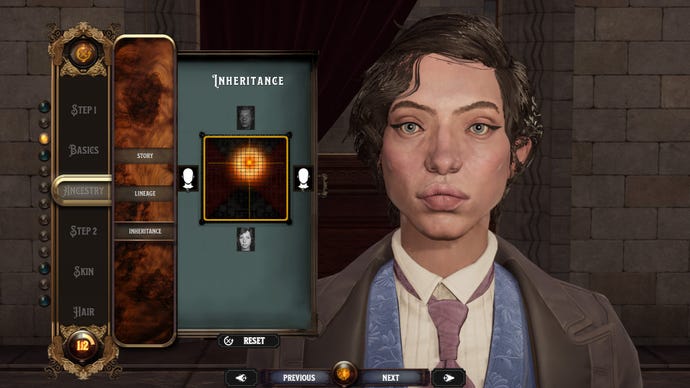
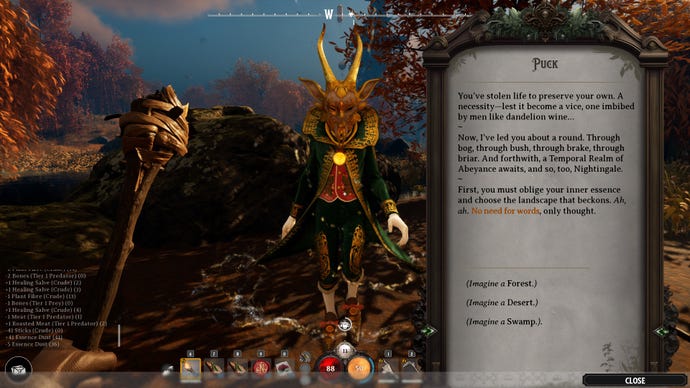
The other way Nightingale makes procgen interesting again is to characterise the generation of worlds as the act of drawing from a deck of enchanted cards. These Realm cards allow you to choose the biome, difficulty and approximate inhabitants of the world you'll visit when you step under the arch of a mystical portal, with cards for weirder, more challenging and rewarding varieties of Realm created or acquired through quests and exploration. It's a wonderful idea that ties Nightingale's world-building to much older, analog traditions of "procedural generation", immortalised by Tarot cards and carried on by latter-day physical games such as Once Upon A Time. It makes shifting between worlds feel like telling fortunes, and introduces a sly "gotta collect 'em all" mechanic that I'd love to become the basis for some kind of full-blown card-trading scene.
The landscapes of Nightingale themselves are pretty dreamy. The premise is that you're a British Victorian-era paradimensional adventurer who is trying to find their way back through the Fae Realms to Earth, in the wake of a terrible cataclysm triggered by humanity/the European parts of humanity's pioneering tendencies. The first biome you'll visit (beyond an initial accidental trip to an endgame underworld, from which Puck swiftly rescues you) is a forest full of overgrown gaspunk machinery, sweeping, flower-dusted hillsides, and high, ruined towers that are olde worlde with a splash of the Monolith from 2001: Space Odyssey.
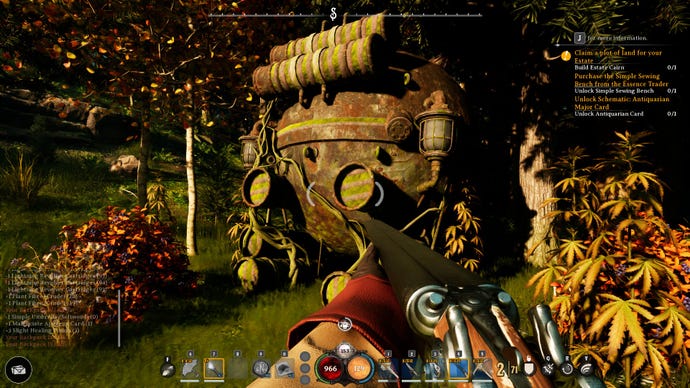
The forest was the first biome Inflexion created for Nightingale, and it feels like the game's soul. Much as procedural generation pulls many variations from the same archive of props and assets, so forests (and perhaps especially, the twisty remnants of Britain's old primordial rainforests) often seem much larger on the inside.
A little further afield, there's a Swamp biome featuring huge iron derricks, where you'll have to worry about slow movement and infections from polluted water. Last but not least, there's a Desert biome that harbours towering observation platforms, where you can play Realm cards to modify the world in real-time - just watch you don't overheat while roving around in full sunlight. The game's weapons and gear include fancy umbrellas, which both guard against hostile weather and can be used for gliding. Initiating a glide after jumping is a little tricksy - I fell to my death, the first time I did it - but it makes for some amusing party multiplayer photography. How's that for traversal, Destiny 2?
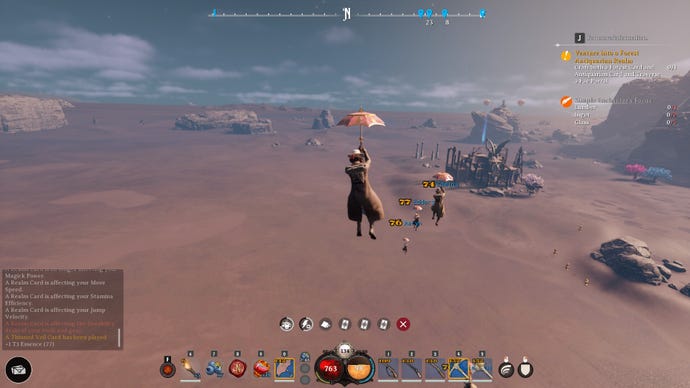
The umbrellas are a gentle homage to Mary Poppins, and the game as a whole is a love letter to British cultural exports. The worlds owe plentiful debts to Narnia, Alice In Wonderland and A Midsummer Night's Dream. You see this lineage in the monster design, too, which ranges from rattling clockwork abominations through monstrous arachnids (or if you turn Arachnophobia mode on, spider-teethed balloons) to sleeping sentient trees who can either be bartered with or felled to obtain rarer kinds of timber. Not every foe is worthy of a campfire yarn: you'll face hordes of club-wielding goblins and larger, tougher variations of the same. But I'm eager nonetheless to encounter the rest of the bestiary, after a few hours wandering the opening Realms.
At its strangest and most elusive, Nightingale reminds me of Bethesda's Elder Scrolls RPGs pre-Oblivion. The Realms compare to the loose cosmography of the Elder Scrolls universe, and the moment-to-moment of this first or third-person adventure has something of the hush and obscurity of Morrowind. I've enjoyed roaming the initial "Byway" realms rather more than I've enjoyed dredging the mists of Enshrouded, or going on safari in Palworld. These are worlds that hold mysteries, as hard as the quest logs and waypoints try to spoil everything.
A small anecdote: after trying out the single player last week, RPS attended a group play session with Inflexion's Aaryn Flynn in which we took on several later-game quests, including a hunt for one of the aforesaid sentient trees. At first, we couldn't find the tree, leading to a suspenseful tour of the surrounding, misty forest, testing our axes on any especially ominous-looking vegetation. Flynn was naturally worried that we'd all lose interest, but I for one loved the experience of getting lost in the woods. Until an over-zealous NPC lumberjack dropped a trunk on me, anyway.
After such glorious tours of the undergrowth - the low sun springing through the boughs and colouring the ensorcelled air, forming a kind of Golden Hereafter at the forest's distant perimeter - it's a shock to stumble out into the open and get told to smash rocks 30 times so you can build a bungalow. The downside of Nightingale's fancy-dan "gaslamp fantasy" premise is that certain underlying survival game routines feel all the more banal in context.


If you've played Ark: Survival Evolved or Valheim you'll know the drill: run around spamming the collect button to hoover up rudimentary crafting components, such as sticks and rocks. From these you will assemble tools such as woodaxes and mining picks, which allow you to break down larger chunks of scenery and obtain the ingredients for floors, walls, roofs, and ambient fixtures such as candles. You'll also construct crafting tables of one kind or another, from tanning racks to sewing stations.
People who adore tweaking a frontierland estate will find much to optimise here. Amongst other things, you can place facilities such as campfires and worktables near one another to unlock ambient bonuses, and the holographic building tool is fairly easy to use. It lets you plot out a series of structures to see what they look like, before you commit the materials.
People who love this kind of thing may also feel, however, that the UI in general needs work. The all-important hotbar at the bottom is stuffed with often-interchangeable icons, power numbers for gear, status effects and ability hotkeys, which often led to me grabbing a weapon from my arsenal at random during more chaotic fights. There's a bit too much faff when looting - open a treasure chest, and you're presented with a wheel of interaction options. I found some menus hard to read: I could never quite work out whether I'd successfully crafted something, for example, or had fallen short for want of materials. Practice makes perfect, and I don't think there's anything altogether broken here, but Enshrouded does a better job of communicating the essentials.
Building a base is the start of your Nightingale adventure. From there, you'll make contact with various factions, including other groups of human refugees, and embark on quests to ancient temples and so forth to acquire the cards for more distant realms that progress the overarching plot. The dungeons I tackled were quite straightforward: in one, I had to descend through the inside of a ruin to a bossfight in the catacombs, where the biggest difficulty was being unable to see my opponent. But during our co-op session with Flynn, we were able to sample a few endgame "raid"-style events that seem worth grinding for.
In one, you have to explore a sandy sunken temple consisting of a series of "find the glyph" puzzle rooms and wave defence encounters. In another quest, we also took on a giant, poison-belching bat ogre, albeit with the benefit of endgame equipment that made said poison-belching bat ogre a pushover. In the absence of artificial playtester advantages, I can well imagine these climactic battles stretching past 10 minutes as players experiment with debuffs, search for weakpoints, and contend with waves of summonable minions. The weapon selection starts you off with crude knives and bowguns, with most fights coming down to managing your stamina. Later, there are hammers with a healing aura alt-fire, shotguns you can load up with elemental ammo, and pistols that can be wielded while gliding with your umbrella.
Nightingale stands apart from the current survival game competition better than I was expecting. It's not the nakedly trashy work of trend-splicing Palworld is, and may undeservedly suffer as a consequence - this isn't a game that lends itself to social media gifs, with too much of the thrill buried in the literary texture and atmosphere of the world. Those literary inspirations also make for a stragglier but more engrossing species of fantasy next to Enshrouded, which I enjoy more in the moment-to-moment but don't feel as intrigued by.
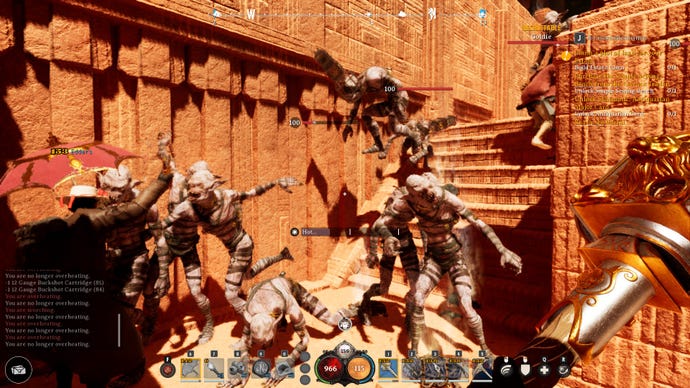
Aside from cleaning up the UI, the major thing I’d like Inflexion to work on during Nightingale's early access period is endowing the bread-and-butter survival game building and crafting elements with something of the mystique that suffuses the world concept, lush set dressing and the Realms card mechanic. This may be too big an incompatibility to bridge, because it runs up against the basic settler mindset of survival games at large, which tend to become tales of imperial expansion and consolidation that drain their environments of interest. By contrast, one crucial trait of a good fairy story is that it's fleeting. The children who discover Narnia might get to be kings and queens for a while, but they’re always sent back to the everyday world eventually. You’re not supposed to settle down in these curious liminal places, these faraway landscapes that linger between standing stones or in the shadows behind the door: the enchantment of the other realm is that it never becomes home.
If you're thirsty for more, we also have a group interview with Inflexion boss Aaryn Flynn, carried out during the aforementioned co-op session. Pullquote: "Norman is a fabulous name for a bear."

















